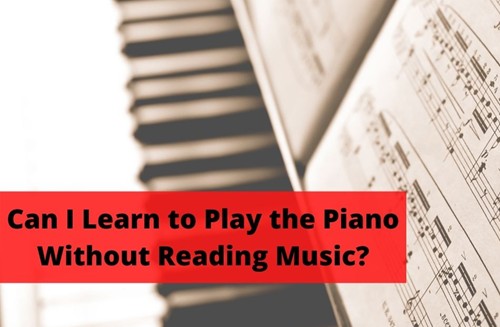Piano and keyboard players alike have different backgrounds and skill sets. There is no strict definitive method that enables any musician to play music.
Anyone can learn to play the piano without reading music. However, if a piano player is not using written music as instruction as to what and how to play, then they must draw from a non visual source such as their knowledge of melodies, chords, patterns and progressions.
The Nature of Traditional Piano Lessons
Traditional piano lessons focus on reading traditional music notation from the very beginning. It’s a skill of precision that must be developed over a period of several years.

It starts with learning the fundamentals of musical pitches as well as rhythm. These musical concepts are displayed on the Grand Staff which instructs a student what to play with their right and left hands respectively.
As a student grows in the proficiency of reading and playing written music, the complexity increases. This in turn allows them to play more complex and advanced arrangements.
Even though there isn’t a mandatory genre of music study for traditional piano students, it’s most often classical repertoire that is the curriculum and goal of learning to play.
It’s not uncommon for traditional piano players to branch out beyond traditional piano study. More contemporary study will usually take shape, which is often in the popular song form.
How To Get Started Teaching Yourself Piano in 10 Steps:
- Establish regular access to a piano or keyboard instrument
- Become familiar with your instrument
- Determine a regular practice/study schedule
- Learn the 12 different notes on the keyboard
- Understand basic fingering positions
- Learn to play simple melodic patterns with your right hand
- Develop the proficiency to read simple written melodies
- Learn all 12 Major and minor chords and how to play them with your right and left hands
- Expand your 12 Major and minor chord knowledge to chord inversions
- Integrate your right and left hands together to play 2 handed chord voicings
Bonus Steps:
- Further develop your chord study to add more advanced harmonic and melodic concepts
- Understand and develop the process of reading lead sheets and chord charts as well as interpreting sheet music to your advantage to play your favorite songs
Should I Ever Learn to Read Music?
Before I answer the question as to whether or not you should ever learn to read music, I really should point out that the term “reading music” can imply more than one way of discerning notes on a page.
On the surface, reading music can be defined as reading traditional music notation with all of the notes, dynamics and articulations that a traditional piano player would encounter within an arrangement.
On the other hand, written music comes in different forms. The different forms I’m referring to are lead sheets and chord charts in which I’ll cover later in this article.
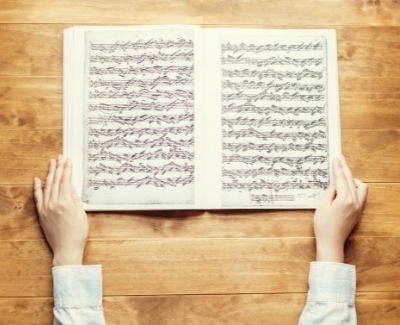
If your question is “should I ever learn to read music”, then you should examine your musical goals. If you have a strong inclination to play classical repertoire, as written and within the boundaries of all the rules that it requires, then you should learn to read traditional music notation.
If your desire to play piano falls more in line with popular music (you know, the stuff you grew up listening to on the radio), then reading music the traditional way is not a requirement. The reason that this is so is because the popular song form follows some different structure and principles than classical music.
But let me emphasize that learning to read music (and yes even traditional music) is beneficial and opens up the doors to understanding music principles. The difficulty of learning to read music has always been a sticking point and a source of frustration in traditional piano lessons.
The Challenges of Learning to Read Music
- It’s essential to read notes and note values at the same time
- Traditional sheet music requires reading of two different sets of notes with two hands (the bass and treble clef)
- Beginners start out at the most basic level which often causes them to get bored
- It’s tedious which causes most beginning piano students to get frustrated
- It often takes a considerable amount of time to learn to read at a proficient level
- Beginning piano pieces aren’t satisfying arrangements
The Difference Between Playing Classical and Contemporary Music on Piano
Classical music is a form of music created or founded in Western cultural traditions. It has its roots in both religious and secular music. While the period from 1750 to 1820 is also referred to by a more exact title (the Classical period).
Between 1550 and 1900, known as the common-practice period, the core rules of this tradition were formalized.
As a classical piano player, it’s required to play the pieces in the repertoire as written, in the style of the time period in which they were composed. Since audio recording technology did not exist at the time of their origin, the written recording is the only original reference to the composer’s original creation.
Any form of improvisation or reharmonizing is discouraged. This is especially true for piano study in an academic setting such as a conservatory.
The popular song form possesses traits that are quite different. One very different aspect of popular music is that the melodies are structured in a way that makes them memorable. And you can actually hum or sing most any melody of any popular song. In addition to that, it has lyrics that make them even more memorable.
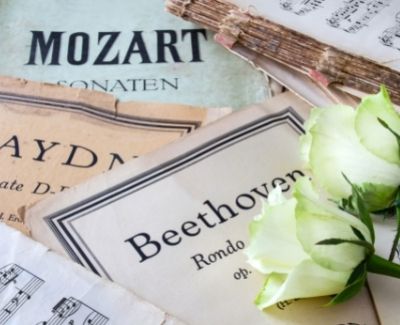
Take this in contrast with classical music and you’ll find that many times the melodies are complex and are even at a very fast pace. And there are no lyrics so they don’t lend themselves to be very memorable.
There’s always exceptions such as Pachelbel’s “Canon in D” or Beethoven’s “Moonlight Sonata”. These pieces fall into a category of well loved classical music because the ear can follow along which of course has the characteristic of popular music
The popular song form also has a structure that makes them even easier to memorize and relate to the ear. You have the introduction, verse, chorus, etc. These aren’t typical elements of classical music and differentiate the two styles very noticeably.
The Beauty of Lead Sheets and Fake Books
As I mentioned earlier, other forms of written music exist to make it easier to translate into actual music. In fact, this is the way most contemporary professional musicians play music. They don’t typically take the time to study and practice fully written arrangements of sheet music.
This is especially true if they have been hired for a gig on short notice. Contemporary musicians need a system that allows them to draw from musical knowledge and skills that they already possess instead of having to start from scratch from a written piece of music.

The need for a type of music shorthand that addresses the challenge of communicating music in written form was essentially created many years ago. It’s called the number system.
The number system is also referred to as the Nashville number system. It’s simply a system of transcribing a key of music by assigning a number to each scale degree in a key of music.
These numbers are used to denote chord voicings and chord progressions.
The Number System in the Key of C Major
| Note | Formal Name | Numbered Tone |
|---|---|---|
| C | Tonic | 1 |
| D | Supertonic | 2 |
| E | Mediant | 3 |
| F | Subdominant | 4 |
| G | Dominant | 5 |
| A | Submediant | 6 |
| B | Leading Tone | 7 |
| C | Octave | 8 |
In addition to the number system, a contemporary musician has lead sheets and fake books at their disposal to instruct them on what to play.
A lead sheet is a rather simple arrangement of the treble clef with only a simple one note melody line and chord symbols to signify the changes in harmony throughout the piece. It is not intended to play as written.

Instead, lead sheets are intended to “lead” the musician throughout the song with this minimal information. Beyond this is where they will interject their own musical knowledge and skills to flesh out the piece of music.
A collection of lead sheets is called a “Fake Book”. The idea behind the name is that a musician is essentially faking the arrangement that they’re playing, because of course they’re not reading everything that they’re playing.
The How to Start Playing Piano Without Reading Music
- Know and study the number system
- Learn all 12 Major keys of music
- Learn all 12 Major and minor chords
- Choose a specific song and learn to play it with a simple single note melody
- Harmonize the single note melody with the chords
- Expand to two handed chord voicings and include the melody
- Learn other music concepts that embellish the melody, rhythms, harmony and other aspects of music
Interpreting (instead of reading) Sheet Music
With traditional sheet music having more information than lead sheets, one could still use virtually any arrangement to utilize it in the form of a lead sheet. For example, simply ignore the bass clef entirely and only use the treble clef and the most upper notes of the melody.
If chord symbols are present (more and more publishers are using them), you would also utilize them as a guide as to what the harmony of the song consists of.
Playing the Piano By Ear
By definition, playing the piano by ear is the exercise of playing music through an aural process of musical skills and ability without any written information of the harmony, rhythm, melody and other aspects of the music.
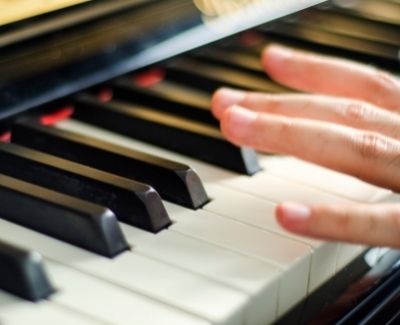
Most people think that playing by ear is simply a gift that a musician possesses without any type of training or learned skills. And even though a musician may be gifted, this isn’t always the case. Instead of just hearing a song or piece of music, a piano player that plays by ear has an aural thought process instead of simply hearing music and magically playing it.
When a piano player plays by ear, they are referencing the bass notes, melodies, chord qualities and rhythms throughout the song to play it the most accurate way they can. This way, they can replicate a known composition or even what they hear inside their own head.
The “Hybrid” Piano Player
I loosely use the term “hybrid” to describe a piano player that will utilize their skills of playing by ear and that of lead sheets and even chord charts. I’ve covered lead sheets earlier.
Chord charts aren’t too far of a deviation from lead sheets. They contain chord symbols and usually slash marks to denote the pulse of beats in every measure.

Your hybrid piano player is one that utilizes their play by ear skills as well as referencing chords from a chord chart.
This would especially be the case if they were playing songs that they were unfamiliar with. And you could throw lead sheets into their tool box because there isn’t a giant leap from going from leads sheets to chord charts.
The Rhythm Piano Player
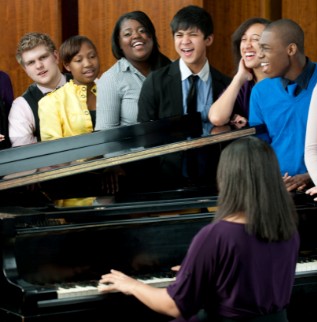
Playing “rhythm piano” is exactly as it sounds. A rhythm piano player is one that plays the harmony through rhythmic patterns and chord voicings that complement and capture the essence of the song.
Under these circumstances, the melody of the song will be played by another instrument or more commonly, it will be sung by the human voice.
This is known as “accompanying” or “comping” a vocalist. A rhythm piano player is not necessarily the solitary skill of a musician but may just be their role at any given time when they’re engaged in the practice of comping.
| Traditional | Contemporary | Contemporary By Ear |
|---|---|---|
| Classically trained at an early age with a traditional instructor | Mostly self taught with some classical training | Mostly self taught with some training from other ear musicians |
| Reads music well | Can read some music but is more proficient with chord charts and lead sheets | Mostly plays in the context of chord patterns and progressions |
| Plays arrangements as written in standard music notation | Will sometimes use written music as the framework to play | Mostly plays songs through an auditory understanding of patterns and progressions |
| Most often will have difficulty playing an arrangement without traditional written sheet music | Usually doesn’t strictly follow traditional sheet music but can interpret it by following its most essential elements | Most often doesn’t benefit from sheet music but may rely on chord charts if necessary |
How Long it Takes To Learn Piano
The most subjective question that an aspiring piano player can ask is “How long will it take me to learn how to play the piano”?
More definitive answers can come from objective questions such as “How long will it take me to repair my car with a broken fan belt? Or, “How long will it take me to prepare and fully cook a chicken casserole”?
The time to complete tasks that are under a few hours are usually pretty easy to assess. But learning to play the piano is a skill set that is developed over a longer amount of time.
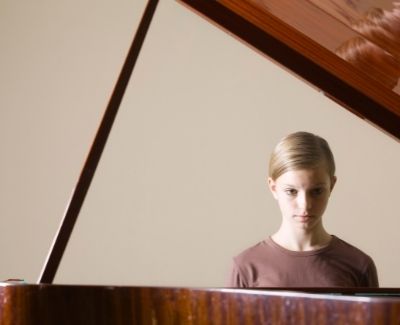
So first, the skill of learning to play the piano has to be addressed in context because as I’ve shared with you in this article, there are different ways to play the piano.
If your definition of learning to play piano is through a traditional method, which encompasses reading music, cultivating your music reading skills, playing classical repertoire and all of the precision that it requires, it will be a process of several years.
This doesn’t mean that it will take several years to actually play. But the traditional method is one that teaches you how to play in a particular style that’s based on reading music. This style of learning piano takes time to develop proficiency and read pieces that approach advanced level skills.
It’s very helpful to have in person instruction on a weekly basis due to the technical skills it takes to play written scores with the accuracy that it requires.
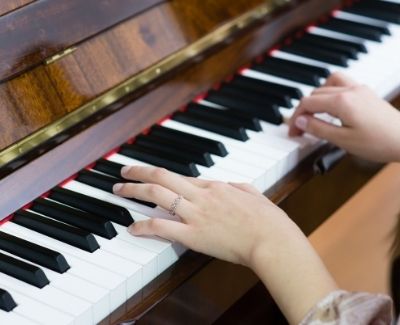
Students that consistently practice and attend lessons regularly can expect to learn to be a proficient note reader and play intermediate pieces in 2 to 5 years. It’s difficult to pinpoint because everyone comes to the table with different skills and abilities.
Be patient if you’ve chosen to learn piano with traditional piano lessons. The younger you are, the better you’ll be as a beginner because you have the time to develop the essential skills you need to play in this style.
Beyond traditional piano lessons is learning piano in the context of chords. This involves lead sheets, chord charts and playing by ear. It can also be a combination of these elements.
Unlike traditional piano lessons, learning piano in the context of chords isn’t as strict as traditional piano lessons. To start with, classical repertoire isn’t the focus of chord methods.
Popular music is more centered around playing with chords. It’s open to interpretation and improvisation as well as playing something in your own style or way that you think sounds good.
Reading less notes while playing more notes is the result of chord style piano skills. Depending upon the skills you may already have, learning piano in the context of chords could take a period of 3 to 9 months.
This could put you at a skill level that allows you to play your favorite songs in a credible fashion without sounding like an amateur. Just keep in mind that chord style piano playing isn’t a path to playing advanced classical repertoire.
Final Thoughts
Now that I’ve shared with you some distinctions about learning to read music and learning piano, I hope you have received some insight to help you make a decision as to what direction you wish to go in learning to play piano.
If you’re a traditional piano player, you can always transition your piano skills into popular music.
But keep in mind that you’ll have to develop some new skill sets because written arrangements of popular songs don’t often sound like they’re supposed to.
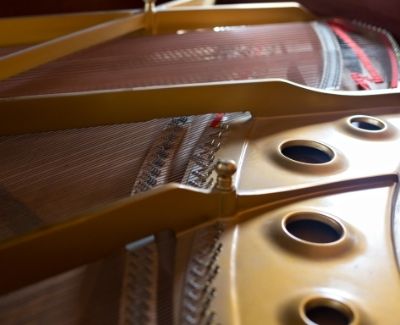
A classical piano player will often play songs in the style of the genre that they started out learning in. If a new skill set isn’t learned to accommodate the transition over to popular music, then the songs they play will often sound like classical versions of popular songs.
If you’re a non-traditional piano player, you can always transition your piano skills into classical music but again, you’ll also need to develop a new skill set for it also. This will involve learning to adhere to the written page more so than you may be used to.
So you’ll have to get up to speed on reading music. I will say that it would be beneficial to stick with classical pieces that are well known and have characteristics of the popular song form as I mentioned earlier.
Greg Lee
Latest posts by Greg Lee (see all)
- What is a minor/Major 7 Chord? - October 26, 2023
- 7 Chord Substitutions that Professionals Use - October 19, 2023
- 5 Simple Chord Tricks to Sound Amazing - October 5, 2023

